with 🎙️ Alan Condron, Scientific Researcher and Climate Modeller at the Woods Hole Oceanographic Institution
💧 Woods Hole Oceanographic Institution (WHOI) is the world’s leading, independent non-profit organization dedicated to ocean research, exploration, and education.
What we covered:
🍏 How Iceberg drift in oceans can be modeled and what can be learned from it
🍏 How large an Iceberg shall be upon arrival in Cape Town, to cover 20% of the city’s water needs
🧮 How that Iceberg would behave all along a towing route that would lead it from Antarctica to South Africa
🍎 How challenging it would be, to harvest the Iceberg’s water upon arrival
🔍 The ecological impacts of an Iceberg tow
🍎 The bigger picture around Day Zero and Water Scarcity in arid places in the world, like Cape Town
🔍 How the ecological impacts of a one-time tow are probably negligible while the consequences of a repeated commercial-scale activity would have to be studied
🍏 How a successful proof of concept would enable verifying theory and possibly build the suited infrastructure to extract the best out of the Iceberg.
🍎 How an Iceberg tow to Dubai is a different game than a southern hemisphere destination
🍏 The financial equation of an Iceberg towing project, the scientific approach that would enable us to learn from the first tow, Nick Sloane’s project… and much more!
🔥 … and of course, we concluded with the 𝙧𝙖𝙥𝙞𝙙 𝙛𝙞𝙧𝙚 𝙦𝙪𝙚𝙨𝙩𝙞𝙤𝙣𝙨 🔥
Teaser: Iceberg Harvesting
Resources:
🔗 Check WHOI’s Website

is on Linkedin ➡️
Infographic: Iceberg Harvesting
Alan-Condron-Climate-Modeller-Iceberg-TowingRelated Video: Iceberg Harvesting
Table of contents
- What we covered:
- Teaser: Iceberg Harvesting
- Resources:
- Infographic: Iceberg Harvesting
- Related Video: Iceberg Harvesting
- Full Transcript:
- A postcard from… Cape Cod
- Introducing: Alan Condron
- Getting introduced to Iceberg Harvesting
- How to tow an Iceberg?
- What to do of the Iceberg upon arrival
- Sizing the challenge: How big will the Iceberg be?
- Next challenge: overcoming the melting process
- 60 Days, 2’500 km
- Various strategies to tow an iceberg
- How big shall the Iceberg be upon departure?
- The team dealing with the Cape Town Iceberg Harvesting Project
- What’s the context around Iceberg Harvesting?
- Iceberg Water vs Desalinated Water
- Ecological Impact of Iceberg Harvesting
- Most problematic bottleneck – dealing with the Iceberg on shore
- Relationships between the various Iceberg projects
- Sizing the financial opportunity
- Rapid fire questions:
- Other Episodes:
Full Transcript:
These are computer-generated, so expect some typos 🙂
Antoine Walter: Hi, Alan, welcome to the show.
Alan Condron: It’s a pleasure to be here. Thanks for having me.
Antoine Walter: I have to say it’s a very interesting and intriguing topic. We will be covering today, but before jumping into that part, I’d like to open with our good old traditions. And that’s the postcards and you aren’t going to send us probably a salty postcard compared to all the postcards we had so far.
So what can you tell me about the place you’re at? Right.
A postcard from… Cape Cod
Alan Condron: I can tell you it’s beautiful. They have around Cape Code and Massachusetts. I’m actually at my house right now, mainly because of some COVID restrictions and getting my kids back to school and juggling schedules. Yeah. That’s about it. Really moved about a mile from the beach.
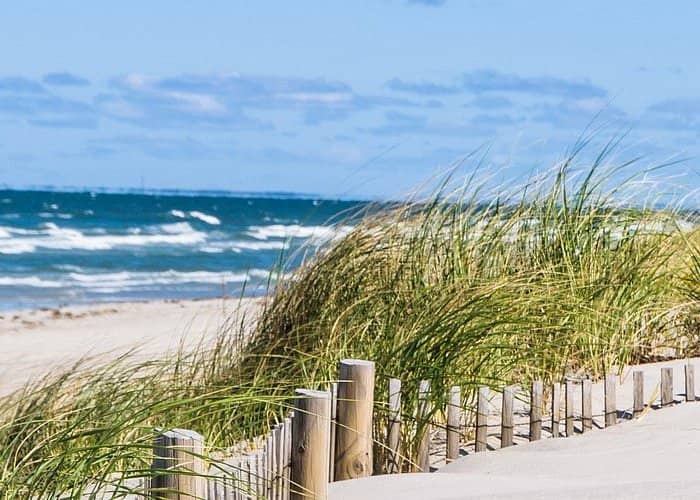
Antoine Walter: So there’s a reason why you were a mile from the beach it’s that has to do with your job. I mean, many people have the beach has something to do with the holiday for you it’s everyday. So maybe you get bored by the beach. I hope not. But can you tell us in just a simple words, what you’re doing?
Introducing: Alan Condron
Alan Condron: Yeah. So we can say a bit about myself too. Yeah. I’m a climate modeler by profession, essentially using numerical models to simulate the climate system, to understand climate change past climate change, to how things could glacial time, scale, and also future climate as well. So, you know, what’s going to happen.
If we keep putting more CO2 into the environment, what could be. Feedbacks, you know, from doing that right. Or the consequences from doing that. So my work kind of, spazzes out a range of timescales, as you say, being close to the beach, you know, it’s inspiring as well, because in my work is obviously based, you’re looking at the ocean circulation and how that changes.
So, you know, the drive to work and you can get some inspiration from driving along the beach and looking out at the sea and thinking, yeah, I can see, I can model that using my computer.
Antoine Walter: You’re working right now at the woods hole ocean Institute, which is according to what I read on the website, at least the biggest Institute of that kind worldwide.
Can you tell us a couple of words about WHOI
Introducing: the Woods Hole Oceanographic Institution
Alan Condron: yeah. So pronounce it when you say hurry. For sure. Yeah. So I may end up saying here quite a lot in this talk. Yeah, no, as you say, it’s a national graphic research Institute. It is large, even on Cape Cod. It’s I think it’s the second biggest employer on Cape called the parent of the hospital was bigger.
But yeah, I know it’s sort of from a scientific standpoint, though, it sort of comes with a lot of prestige. So it’s got in quite feel quite fortunate to work here, actually. And yeah, we’re doing a range of, not myself, but there’s, I think there’s over at least a thousand, you know, sort of science employees doing a range of things and I do computer modeling, but there are people that will say, you know, go out on research boats, you go to the arts.
Yeah. They’re taking measurements of the water. Oh, you’re dropping in gliders and robots, you know, even now into the water and you’re sending them down. And I Woods Holewas also quite famous for finding the Titanic, which, know, sank 1912, I think, it was Bob. It was, he was at woods hole for a while and he was on the expedition that originally found the Titanic.
So it’s this kind of cool!
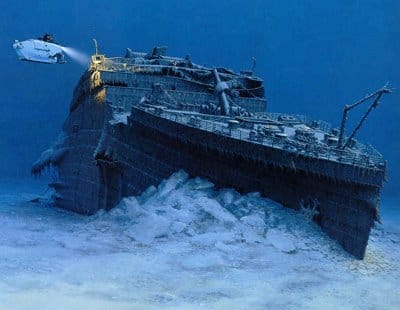
Antoine Walter: It sounds like, like the perfect transition to our deep dive for today because we are going to be talking about icebergs quite a lot, and that all starts with a story I just saw popping up and some auditors that podcast, reach out to me and told me, Hey, why don’t you think about iceberg as a source of drinking water?
Getting introduced to Iceberg Harvesting
And the first time I heard that. Come on. That must be like a welcome side effect to welcome being into brackets of climate change that we are now, considering this kind of marketing moves because, you know, there’s iceberg bottled water, which is incredibly expensive and all of that. So I was really negative about it, but still curious.
And I started looking into it and the more I was looking into it, the more it turned out. Totally wrong. This sounds incredibly legit and hence our discussion today. But before going into the core of the matter, I’d love to hear your own feedback. How did you first hear of that topic of towing icebergs for the sake of drinking water production?
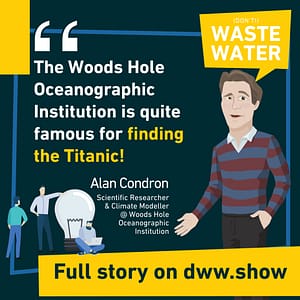
Alan Condron: Yeah, it’s a great question. I sort of came up sort of from it from two angles. I guess one is when I started out. So. My research itself. I look a lot at the polar regions and ice sheets, and I spend the sort of last five to 10 years writing this model. Um, it’s almost like a computer game in a way to simulate icebergs and how they drift in the ocean and sort of, you know, the goal of that model was to think about, you know, things like the Greenland ice sheet start to melting faster on top to go, you know, no more ice bugs going into the ocean.
Might that influence global climate. And then at the sort of same time, you know, having them built this iceberg model, the media, you know, if you, and this kind of gets back to your point, that the media seemed to sort of, you know, periodically put out these ask who was about people who want to tow icebergs, and it sounds a bit sort of.
The recurring topic of Iceberg Harvesting
Science fiction in a way, perhaps right. As you sort of dig into the litterature has been around for quite a while. So I’d say I came across it with the last sort of five years, and then having this iceberg model that I made. Curious, we can talk about this a little bit more of answer about how I could actually use my model to sort of investigate this problem.
But yeah, so the media kind of, so occasionally puts out these are scores and I think, you know, people read them and go, wow, it’s just sounds nuts. Right. But then you, you know, you do a little literature search and you look back and as you’ve just said, you know, you find, since at least since the 1970s kind of a wealth of.
Information. I think it’d be exciting to talk about in a minute is how, you know, how that’s developed over time or not developed actually. I mean, there haven’t been any iceberg toes really performs despite lots of discussion about it. Yeah.
Iceberg Harvesting: a 200 years old project
Antoine Walter: That is a fascinating aspect of that full topic. It’s that I found the first record to be Meade’s 19th century of iceberg towing or iceberg towing projects.
Some people wanting to tell some icebergs to India to sell them some others, trying to bring them to places where they could be crushed for drinking water purposes. So really that is around for two centuries. And. Pretty easy to find the beginning of every project and the full rationale of builds up. But then the reason why it never happens is something which is rarely documented.
So do you have a known explanation of why it’s never happened so far?
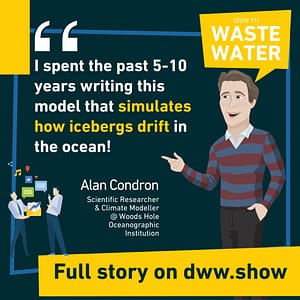
Alan Condron: Yeah. That’s also a good question. I think one of the main reasons, or actually the window, several reasons. I mean, I think. So the logistics of pulling it off, it’s quite challenging. So, yeah, right now people are, as you sort of mentioned, there have been the sort of places where they’ve towed icebergs for short distances and, you know, and was sort of this boutique market at the moment of iceberg towing wise, but using icebergs.
In Canada and Newfoundland, there’s a company that’s is basically, you know, get cutting off little pieces of ice or getting smaller icebergs and they’re using it to brew beer or. To make sort of what, you know, rape pure what they call rape pure water. And this is a market for that. It’s like a boutique market.
Iceberg Water: already in use today
Antoine Walter: There’s the Iceberg Vodka as well, which is called iceberg and which is from Canada. So it’s really a marketing topic to that.
Alan Condron: Absolutely. Yeah. And it’s funny because we were up there a couple of years ago and you know, you look at the boss of the water and its claims it’s 10,000 years old.
Water that you’re drinking because you know, it was the idea that the snow falls on the ice and then takes that long to become the glacier. And then the. Comes down the coast. So do you know, you’re drinking this really old water, but to do it on a larger scale is always been the challenge. I think that we can dial into this a bit later too, but there’s so many aspects actually pulling off the whole thing, you know, there’s the going out and getting the iceberg.
How to tow an Iceberg?
You ha sort putting a line around it, so it’s to move it in the first place and then pulling it up. You know, it’s a way he wants to go with it. And then there’s this huge amount of uncertainties and to you about how much ice you’re going to lose, you know, during the tow, how quickly these icebergs are gonna melt.
And that’s partly where my work comes in as well. Yeah. What is this total even locally? What do you put around the iceberg? Is it just simply a piece of wire, a rope, some type of vape, much more sophisticated insulating machine. That can help preserve the iceberg as it’s towed. But I think part of the problem though, is what do you do with it when you get it to the destination, say, you know, you arrive at your destination where you want to extract the water.
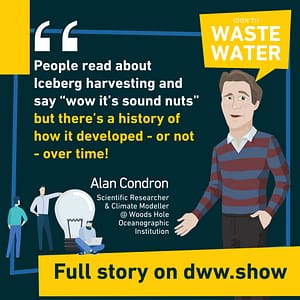
You know, you’ve got some large vessels with behind it. You have this huge iceberg and then you have this issue. Well, okay, now we’ve got this, the iceberg we have to get somehow get this water on shore. Without contaminating it. So we don’t want the salt wars from the ocean to go into the iceberg. And how do we actually go about doing that sort of extraction of the water?
Many open questions
Where do we put the iceberg? You know, you can tow it somewhere. This is an interesting problem, but perhaps not a lot of people think about it as if you’re going to bring a Rooney being iceberg back to a place like Cape Town. Which is having, you know, having water issues will Perth in Australia, your iceberg is going to be quite thick.
So as you start to approach, you know, the Harbor or whatever that you want to extract the iceberg, it’s going to hit the bottom of the ocean quite, probably quite a long way out from where you, you want it. You know, it’s not egg. Just bring it right up onto the beach. And I spoke. I don’t know, it’s water that is usable.
It’s going to be, you know, a hundred, 200 meters thing, for example. So the problem is that as you bring it up to the coast, you’re going to hit the bottom of the sea really quickly. So then you’re stuck offshore and see how to come up with some sort of clever way then to get that water.
What to do of the Iceberg upon arrival
Antoine Walter: Regarding the arrival itself, just before we go into the depth of that, I like just for the muggles, like me, which are not day in, day out, like you’re working with that.
If we can just recap the principle of the project, because when we are talking about iceberg, we opened with the Titanic. It’s not advisement we’re talking of. If I recall what was written in these reports in the seventies, which was read the decade where lots of people were looking at that we are talking of an iceberg, which is several tens of kilometers long.
That size that’s your you’re looking at. If yes, of course you imagine that you’re not dragging that into a Harbor, I guess.

Alan Condron: Yeah. Right. So we’ve, they’ve begun to look at this and the model we’ve sort of gone along is the Cape town idea. So there’s been a guy Nick Sloan has been working on this. He’s a Marine sandwich guy and it’s a project I became involved.
You know, Nick is famous for raising the Costa Concordia back in I think it’s, 2012. And, you know, he, this is, and this gets back to earlier question about how I became interested in this. There was an article in the BBC, I think in 2018 that interviewed Nick and he’d sort of decided. Danny, the Marine salvage expert.
What’s an Iceberg, when you’ve dealt with the Costa Concordia?
He is that if you, he might as well turn his attention to moving icebergs and the hero you’re thinking as a water in a way to really water stress. I thought, wow, this is, you know, it’s fascinating. It’s sort of known about this before, but you know, obviously growing up in England to them. So I’ve heard about, you know, the Costa Concordia, and actually I’ve sort reached out to Nick and said, Hey, I’ve got this.
Iceberg model. Can I help in some way that you will be appointed, but getting back to that, I mean, I did write some numbers down, is that, so when I’m thinking about Cape town as a sort of a case example, you know, Cape town apparently uses 500 million liters of water a day. Which is phenomenal. It’s I think about right.
And so the iceberg that Nick has got in mind to tow to Cape town is going to relieve about sort of one fifth of that. So about a hundred million liters of water a day. That’s the sort of iceberg he’s got in mind. And say, you know, chatting with Nick and a little while ago, and I spoke that to provide that amount of water.
Sizing the challenge: How big will the Iceberg be?
When you bring it to Cape town, it’s going to have to be huge. It’s going to be 600 meters and it goes sometime interesting to me as long, 300 meters wide and 200 meters deep. Okay. And that’s on the, that’s the sort of smaller, smallest size it could be. So, you know, these are quite large, I suppose, on a rhyme.
What we’ve been doing is thinking about, well, what does that Iceberg needs to be when you, you catch it in the first place, because it, as you go get it and you tow it somewhere it’s going to Mount. Right. And so to think about how much melt is lost during the tow. And so, you know, we’ve done some, this is where the, my model has come into this work to.
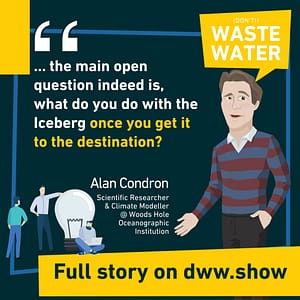
No, how much melt would be lost. And so think about, yeah what’s the size of the iceberg you initially need to target to bring it, you know, to Cape Town.
Next challenge: overcoming the melting process
Antoine Walter: And what is your estimate of that melting rate? Because I’ve seen in the seventies, there was some scientists from the U S army that were saying, if you go to the Ecuador, you have just a tow.
Everything else is going to be melted. It’s 100% melting rates. And that was my best guess to understand why. It stopped in the seventies and didn’t went further and I’ve seen a French project led by Georges Mougin in 2003. And I think Georges Mougin is also working on the project in Cape town. They were working with Dassault system to do a model modeling of all of that.
And they were estimating the melts. So it wasn’t the same route, but on their route, which was between Newfoundland and area. They had, I think 38% melting rates. What is your estimate? I mean, your roots goes from Antarctica to Cape town. How long would that last and how much of the iceberg would melt on that?
Alan Condron: That’s a good question. So dig out some numbers with, let’s see a tow from Antarctica to Cape town, depending on the speed that you’re going to tow it. And the estimated speeds seem to vary between half a knot to one or 2.2, five meters, a second, 2.5 meters a second. In my model, we go for the higher end, which is one we can move in the iceberg at one.
60 Days, 2’500 km
Yeah. Based on some chats with Matt who believes he can pull it fairly fast, but a tow from Antarctica to Cape town is in this terms of distance. It’s still about 2,500. It’s a long way. If you towed, it was not. You can get there in about 60 days, so about two months. And if you could tell it at half an hour, you know, it’s double the time almost four months, but there’s the Cape town route is quite interesting.
And from a oceanographic perspective, because of the proximity of Antarctica. To South Africa for the first part of the toe, if you would go down and look, pick an iceberg that was, you know, drifting around Antarctica, the first parts of the toe is actually in fairly cold water for a long time. You can get quite close to South Africa before you hit sort of more subtropical warmer.
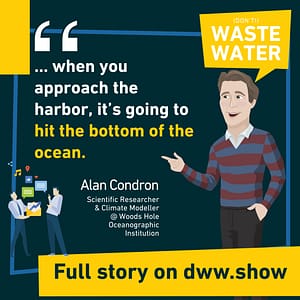
And also the nice thing about the sabbatical too, is the direction of the ocean circulation at that point too. So if you sort of sense, you would want to go sort of the upstream or to the west of South Africa and then down to Antarctica and the ocean currents that will actually be in your favor, they’ll help push the ice boat towards Cape town.
So you’re sort of essentially using the ISP ocean currents. Move the iceberg and you can sort of, then slowly pull the iceberg out of this sort of cold Antarctic water, into, you know, into the subtropics of course, things then kind of really go bad once you get into the warm water, at least in our model.
In subtropical waters it gets challenging
This is when, as you start to approach, can’t tell you’re really losing ice, mass ice in warm water. It doesn’t go very well, as long as people know. So to answer your question about sort of sizes, we did a couple of runs at assimilations in our climate model. The first one, I actually was the sort of take a step back from and just say, well, what’s the smallest iceberg who can survive the toe in the first place.
So if you were to get, go to Antarctica and you grab a piece of ice and then pull it to Cape town, you know, even if it was just a tiny ice cube upon arrival, Would be an initial size. This is quite interesting because the initial size actually turns out to be quite close to what the size that next Sloan wants to have show up in Cape town.
And I spoke roughly 400 meters long and 200 meters there. If you were to go and pick an iceberg that big from Antarctica, and then you towed it to Cape town, that was pretty much the minimum size in our, at least in our model that we’ll make it there before.
Various strategies to tow an iceberg
Antoine Walter: You mentioned the various ways to tow an iceberg.
And again, my only experience here is the literature I read. And there is the first way, which is like all company do so that I’s bruised on collide with oil rigs, which is simply putting a cable and moving it a bit. Then you have. This Dubai project, which is, I don’t know if it’s a competition or not to the Caitlin project, which is the other one alive, currently in the word where the owner of that project claims to have a patented way to drag and to catch the iceberg.
And then you had many projects in the seventies were all around wrapping the iceberg into plastic sheets, or sometimes on the full hate of the iceberg. Sometimes a bit more realistic on the certain part, which is the part which is. Going in contact with the waves. Did you also have a look at the various possibilities and according to you, what is the best compromise between practicity.
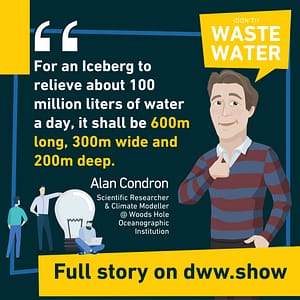
Alan Condron: Yeah. So the answer to your question. Yeah. It’s this, that sort of the second part of our project in a way, we haven’t actually looked at the effects of sort of wrapping the iceberg in, in a material. The yeah, as you said, as you say, there are some quite interesting ideas put forward, so. This material might look like.
Is wrapping it up reasonable?
Right. Whether people would discuss something called it like a geotextile skirt, which would basically just be like a belt that insulates the iceberg around the sort of the, sort of, the wave line. So Icebergs are really susceptible in terms of Melt from waves crashing against the silence. It’s actually one of the biggest ways that I spoke to deteriorate.
So if you can stop that now. Then that’s going to sort of preserve your iceberg for longer. Yeah. The other ways as you’ve described there, as that too rapid, you know, there’s been ideas to wrap the entire iceberg in some type of material. I mean, this is quite interesting though. So if you worked out the surface area of one of these icebergs, You would need phenomenal amounts of material, right?
If you’re looking at an iceberg, it’s a half a kilometer long way, say, you know, a third of a kilometer wide and it’s 200 meters thick, right time. If you work out the surface area, And then you imagined what that might look like as a material sort of wrapped up on a spool or something. It’s going to be kilometers and kilometers long of material, you know, is it feasible to be able to wrap an iceberg in something like that?
Right. It’s like wrapping someone in bandages all the way from head to toe it’s, you know, it’s a lot, right. What we’ve done in the model so far is we’ve just been looking at what we call unprotected iceberg. So they’re not insulated in anything. And that’s sort of where our basic melt calculations have come from, but yeah, and to get back to that too.
How big shall the Iceberg be upon departure?
So if we wanted to get an iceberg to Cape town that could provide a significant amount of water, say it’s one third or one fifth of it, of the drinking water, the estimates still come out fairly good in the United States at a kilometer long, and our model by 600 meters wide. And 300 meters thick. It might sound really big, but in terms of Antarctic icebergs, it’s actually not anything unusual.
You wouldn’t have any real difficulty in Antarctica of finding an iceberg like that. You know, there are ones that are much, much bigger, so you know that yeah, you could sort of locate one of those and then pull it back. So that survives the toe. And then when in our model, and then when that gets to South Africa, it provides.
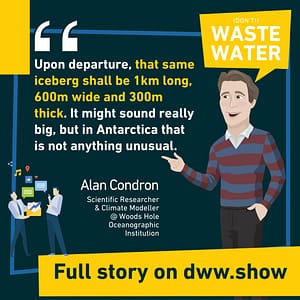
The required amount of drinking water, which is about a hundred million liters a day. There’s this sort of caveat with that though, because if you just leave your Iceberg. So you bring it back and it’s brilliant. It’s the right size, right? It’s got all the wards you need, but if you live it off shore, you don’t do anything with it because it’s surrounded by essentially subtropical waters, which are know 25, 20, 25 degrees C at temperatures, a similar temperature and our model.
Beware: in 2 months, the Iceberg is gone!
If we live it off shore for two months, it’s gone. It’s completely melted. I mean, you’ve got this massive iceberg and it’s great. And it’s, but it’s got all the water that you need to help alleviate drought in South Africa or in Cape town, especially. But if you don’t, if you can’t harvest that water instantly, or if you can’t find a clever way to stop iceberg melting, like if he just laughed it off shore and he was standing on the beach everyday, looking at him from Cape town, you, our model would be gone after two months, you know, that opens up another.
And then another issue with the towing, right? What do you do of the iceberg when you get it to its destination? You’ve asked to come up with some sort of clever way. It’s very quick, either very quickly harvest the washer or to stop it mounting as well. That’s a huge challenge.
The team dealing with the Cape Town Iceberg Harvesting Project
Antoine Walter: So in the Cape town projects, you have Nick’s loan, which is, I guess, dealing with the actual towing.
When that’s his expertise, you are looking at the model of what you need to have as a size, then what you need to drag. Who’s looking at the parts where the iceberg is actually next to Cape town and you need to crush it in order to turn it into drinking water.
Alan Condron: That’s a great question too. That’s actually part of the aspect of not actually.
All that too familiar with. I know that I think on Nick’s team or some of the presentations I’ve seen by now, he has discussed ways. You described ways that you would extract this water. This idea of sort of open was what would appear to be like an open cast mine, where you have an iceberg and you can then drill down through inside it.
That doesn’t avoid the problem of, if you have an off shore, it still doesn’t get around the problem that it’s going to be setting in re warm water. Right. There’s also been, I think there’s been just ideas about bringing these things into like dry docks, you know, where you could somehow bring it close to the shore or yeah.
Whether you sort of could break it up into smaller pieces. I think that, you know, getting back to earlier points. What are some of the reasons this, perhaps this hasn’t been pulled off as a viable way for washer is, yeah. There’s, it’s the harvesting aspect of the iceberg
Comparing the Iceberg’s size
Antoine Walter: just wanted you to compare it quickly just to put in to compare reason.
If I take the iceberg, the size of your, you mentioned, you sort of said 200 meters deep.
Alan Condron: 600 meters long, 300 meters wide. And about 200, right? Yeah.
Antoine Walter: So these 200 meters thick. I mean, the part is going to be, I would say the water, but we know the metaphor of the iceberg. So a lot of it is going to be under water, but if we compare it to a ship, like, I don’t know that the queen Mary or there’s probably a bigger one.
Now, how bigger is the iceberg? Just to get a comparison.
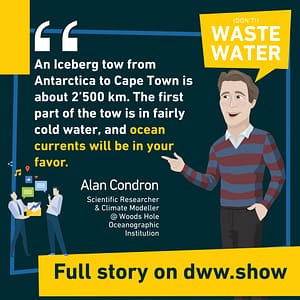
Alan Condron: Yeah, that’s a good point. Well, yeah. So the classic analogy about the, you only see the tip of the iceberg, right? I mean, so attend a 10th of the, roughly about a 10th, an eight to a 10th of the iceberg is below the water. Right. So if you’ve got a 200 meter iceberg, you’re going to be looking about 20 years.
Above the water. It’s quite funny. Cause it will look quite small actually from, oh, it won’t look like it’s that thick. If he was standing on the shore, looking at it because you know, 180 meters of it would be under the water and the entire show. How long the queen Mary is
3 Queen Mary deep
Antoine Walter: it’s about 70 meters deep.
You don’t have the same ratio of 10 to 90% between what’s submerged and what’s not submerged, I guess you cannot drag. I mean, I guess it must be difficult to drag your ass up to the shore as you were mentioning before. And even if it’s not the shore, even if it’s a horrible, which has meant for those big ships, it’s probably still not meant for an iceberg or maybe you don’t want to block it for Harbor because you’re Harvard seeing an iceberg for the next two months.
So arrival is going to be tricky.
Alan Condron: Yeah, absolutely. Yeah. If you, if, you know, if you go on Google earth or something you can look at it, look sort of watered down it’s, you know, around Cape town, for example. And you know, as you get towards K-Town that area around South Africa, as you come up onto the continental shelf quite quickly, you know, the water gets shallow and then you have a quite a long distance before you get to land that’s, you know, is shallower than the thickness of the iceberg.
That’s the problem.
What’s the context around Iceberg Harvesting?
Antoine Walter: But still, if I put all of that a bit in context, Cape town was facing this day, zero in 2017, 2018. Some rains saved the day, but I mean, climate change is not going to disappear. So chances are that these Day Zero. Come again. And we estimate, I mean, there are several studies by 2030, the word is going to miss about 40% of the needed water resources, just to cover our needs.
For sure. You can still find a compensation somewhere we’ve been discussing on that microphone, how you can reuse water, how there’s lots of options, but still it’s quite intriguing that in that context, you have so much renewable water in those Icebergs. And no one ever said. Let’s try it. Maybe we end up with just a tow, but still in terms of magnitude of cost, it doesn’t sound to be really from another world.
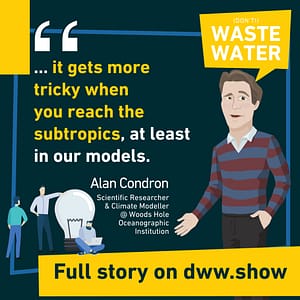
I mean, the Dubai project was mentioning about 100 million to do the tour. If I look back in the seventies, the projects were all between this 30 and 100 million landmark, do you have an estimate even really ballpark estimate for the project in Cape?
Alan Condron: Not off the top of my head. I know from Tim earlier discussion of next loan, he has, yeah, he’s done some sort of cost benefit analysis, I believe, but not really.
A holistic take at the Iceberg project
There’s a lot of things to factor in. I think, you know, it’s the, yeah. The cost of the vessels that you’re going to be using, having the crew it’s as we’ve sort of discussed earlier, it’s not a, it’s not a shame. Tow, it’s going to take, you know, a couple of months to move this thing. I mean, it’s cost the fuel, you know, for the vessels themselves.
And there’s actually, this is sort of, it’s very, in my mind onto another topic, which we perhaps can touch on a minute, there’s this sort of environmental impact of actually performing the toe as well. Right. So, you know, if you’re gonna. Burning a lot of diesel to pull these icebergs, you know, towing vessels.
Is there a, you know, is there a carbon footprint or what’s the carbon footprint associated with performing the toast? It’s something that’s going to be performed routinely, you know, that needs to be discussed.
Iceberg Water vs Desalinated Water
Antoine Walter: I guess it’s a matter of what’s the benchmark, because if you’re not getting a water from an iceberg, you’re probably getting your water from a desalination plant.
And desalination plants, they’ve made lots of increasing in performance and it’s much better today than it was maybe 20 or 30 years ago. But still there is a base principle, which is a you’re taking out soul from the water, which means you’re returning that sold somewhere to the ocean. Quite bad in terms of the ecosystems of the ocean.
And of course it needs a lot of energy to take that salt and the Brian’s out of the water and to separate water and sold them really. Hitting open doors, but we are comparing an iceberg tool to a dissemination plan, not to a river, I guess that wouldn’t make sense compared to surface water, because I saw that was also one of the discussions around in Cape town.
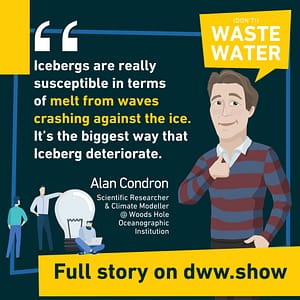
So the ecological impact. I see double-sided on the way. Of course it’s not the natural place for an iceberg. So probably the recipe or an impact that when something called in hot water, but on the other side of that same story, if you’re disseminating at the exact same place where your iceberg is melting, while all of a sudden you’re adding fresh water in a place where usually you’re only returning Bryans and heavily salted water.
So maybe you’re striking a balance. It’s really muggles inputs here, but on the ecological point of view, Did you or someone of the team have a look at what would involve to actually to an iceberg on that route and to habits melting next to.
Ecological Impact of Iceberg Harvesting
Alan Condron: Yeah. So we’re beginning to open up discussions that would solve with our biology department to look into this.
And you sort of hit the nail on the head. You completely that, right. It’s sort almost the opposite of desalination, right? With the iceberg, you know, you’re moving up, you know, this code sort of rephrasing thing into a warm environment. And then as it melts, it’s releasing cold, fresh water. So yeah, there’s, you know, what’s then the consequences.
Of the iceberg, releasing that water into the environment and, you know, sort of second know it’s gone from that is the fact that the icebergs, you know, as you bring them on shore and they ground on the floor. Right. So there’s also. There’s cold waters can be released on the sea floor too. So, you know, it might be creatures that live down there.
The preliminary study is I’m looking at it in the model where you actually just towing the iceberg through the water, the sort of signature leaves behind it. It’s in its wake and its path is actually quite minimal because it’s such a small. It’s so small in terms of the large scale lotion, right? I mean, it might look big when you’re looking at it and, you know, half a kilometer, long iceberg, but on the grand scale of the global ocean, it’s you know, a drop in the water almost.
A drop in the Ocean?
And in the mall as we move this thing from toxic it’s K-Town, we can look at how the release of this cold, fresh water is changing the ocean properties and insulin. The slanty, all the temperature is brown rice, rice, like rice, more. In fact, it’s done. So, yeah. The I spoke to its destination there that then you potentially running into trouble.
Right. Because then it station is in one place and it’s constantly just releasing cold, fresh water and so their environment. And so, yeah, no, that’s what we’re now discussing with the sort of biology department here at woods hole is if you were to look at what sort of species of fashion, you know, Marine creatures live in that environment, you know, can they tolerate.
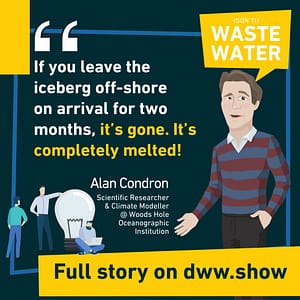
And do they even care? I mean, if anything, they just move out of the way a little bit and they won’t really be impacted by it, or is it going to be significantly worse than that, that it has a much more detrimental impacts. And you can imagine perhaps that just doing it once wouldn’t really have a huge impact, but if this was eventually to become something that’s a bit more commercially viable practice, the repeat process over time.
What about scale?
You could sort of have a larger knock-on effect. Right. And I think, yeah, so this gets back to the year that the harvesting of the ice. And I think that it needs to be a sort of clever way perhaps to when you get the iceberg to its destination, to stop it, losing all that fresh, cold, fresh water into the ocean, somehow, because as the model shows as well, if you just leave it there, it’s going to move extremely quickly.
It’s going to melt so quickly. You’re not going to be able to extract enough water to. You know, to solve your water crisis.
Most problematic bottleneck – dealing with the Iceberg on shore
Antoine Walter: So if it gets you’re right, I mean, we’ve seen that you still need to capture as burgers, still need to tow it. You still need to bring it. It has to have the right side, not to melt on the way, but all of that seems to be more or less in control.
According to your modeling, the bottleneck today is what do you do upon arrival? I mean, all the rest, I have the feeling, listening to you that it can be sorted out. Once you bring it. If you’re not able to do something fast enough, then you start having maybe ecological programs, maybe your money invested is melting away.
And all of that then is for nothing. If you look at the first destination plans, if you look at the first time, every kind of technology has been put in place worldwide, it’s never perfect the first time. So I’m wondering what we need for someone just to say, okay, it’s not perfect. It’s not going to perfect.
Probably our iceberg is going to melt there and we’re going to take maybe two bottles of water and it was probably not worth it, but we did it.
Alan Condron: No, I think absolutely. Right. So, and that’s my real interest in this project too, you know, it’s easy to focus on the negative things. Right. All the things that could go wrong.
Can we learn by doing?
You know, with the capturing the towing the harvesting of the extraction at the end. Right. I think at the end of the day, yeah, just performing a toe to see if it’s actually possible is really important, you know, to go and do it. And then, you know, if you say. Yeah, you get this iceberg and you get it to Cape town.
And it’s just a, it’s just a trial and expanding, right. As you’ve sort of said, it’s not, you know, aiming to solve the water crisis of one iceberg, but perhaps, you know, you get into Cape town and you should sort of back up and say in a climate model. And I spoke model is just a model and it’s based on some equations about how we think ice melts in the ocean.
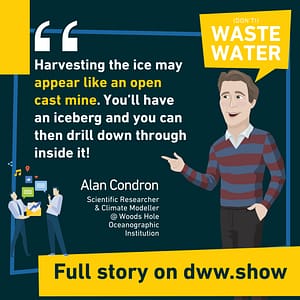
And it’s probably not perfect in any way. As if you perform an actual tow, maybe we’ll find that doesn’t matter as fast as the model predicted. For example, you know, maybe it survives a lot better. You end up with something that’s much bigger. Maybe we found we could pull it faster than we already thought.
You know, this idea that you can pull it at half an hour to a knot. If you sort of poke around or there’s chairs, there’s this, it’s not really based on too much. Theory. There was some ideas. If you pull it, pull the big iceberg really fast, they would sort of start to oscillate almost like in a wave kind of pattern.
Experience will tell
And then that would cause them to break apart. Maybe it’s possible. Pull much faster than we think too. So, you know, you can show up in Cape town when I suppose much bigger than the model ever, or the theory behind it ever predicted. And I think then if you said, this is great, you know, and you could work out how much water left in iceberg when you get it to where you want it to and say, wow, this is really like a really sort of financially viable amount of water.
And it’s a volume of water. So that could help, you know, alleviate some sort of drinking water crisis. And I think then is to say, right, well, wow. You know, what do we need to do then to get this washer on shore? And perhaps then it’s the sort of sit down. Right. Yeah. What would the infrastructure needs be?
Right. Some sort of perhaps dock-like facility that sort of has a sort of deep water channel grabs that you could bring the iceberg in, on, and then once it’s in there, maybe you could sort of shut a door behind it. You know, if you can get rid of all the soul salty seawater and the iceberg, that’s gonna make it.
The proof of concept will need to be monitored
A lot easier with your extraction because what you don’t want is salt water getting him of your iceberg water. The iceberg is one of the sort of beauties about the harvesting, I suppose, as the is extremely fresh. And so you don’t really need to treat. To drink it. I mean, you can actually just drink it and we’ve done this in the students in Newfoundland where, you know, you can get a little iceberg and you can put it in a cup and it’s, it tastes amazing.
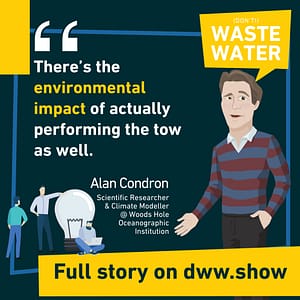
It’s pure and it’s fresh. And so, yeah, it’s a fight. It’s come up with a way to be able to extract that water without the salt water getting into it. I don’t believe you can just leave it off shore and cause it would disappear. But yeah, if you can do a tow and you can show that it works. I think that itself would open up a huge window of opportunity to sort of move this work forward, move it out of the sort of realms of science fiction, fantasy, move it to something that really could work.
Relationships between the various Iceberg projects
Antoine Walter: Do you have any contact with the Emirates project led by Abdulla Alshehhi?
Alan Condron: I met him. I actually met him at MIT a couple of years ago. He was visiting and he was talking about, he’d been raising and trying to raise a lot of money to pull off his product. And it was sort of, we sat down and I showed him. So my model actually, what it could do.
Yeah. I know there’s been a lot of interest in United Arab Emirates for quite a long time now, right. About this idea of using ice.
Antoine Walter: There was this conference in 1977, which was funded by the Arab Emirates. I read that was the moment in time where they had the most expensive piece of ice, because for the sake of the conference, they brought to the IOA, a university, a piece of ice that was captured in, I think it was Newfoundland and Alaska or some somewhere around that.
And it came back by plane and recapture is of course. It’s an expensive piece of ice that you put in a cocktail, but there was always interest in the seventies. And as much as I understand that project, it’s really the full up of that story. And if I got it right to them as well, the first stage of the tow would be to tow it, not to Dubai, but probably to South Africa or Australia, just to say, look, the tow is feasible.
So I was wondering if you’re competitors to that extent or if it’s really, if someone ever does it, it’s opening the door to everyone there.
Will the first-mover start a new era?
Alan Condron: Yeah, that’s a good point. I mean, in terms of actually getting, you know, fresh water into sort of the you know, large scale sort of a drinking water system, right.
You don’t need to tell it right to the final destination, you know, almost perhaps you can get the closest piece of land you can get it to. Right. Is one way to think about that. You know, we looked at, you know, in the model where just some simulations with telling and I spoke to like Dubai. Well, the tow for it takes over a year and you have to transit across the equator.
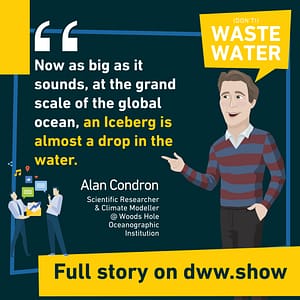
So your iceberg is an exceptionally warm water for a long, long time. Yeah, no, I think you’re absolutely right though, in terms of once they’re sort of done in one place, you know, whether it could be pulled off, like telling I spoke to Perth as well, so. You know, proposed, I think, and that’s very similar in a way to take one to Cape town.
They both have the oceanography and those regions have both raise similar in terms of your close to Antarctica and also the ocean current sort of benefit you, that it will push the iceberg towards your final destination, both those toes, the Cape town on the south African. So, so Cape town on the Australia, so are pretty much the same distance.
Sizing the financial opportunity
Antoine Walter: Maybe to me last question in this deep dive it’s around the financing. I know you said that you don’t necessarily have all the numbers for the actual project, but when I was reading the report from RAND from 1973, they were making an estimate and it was saying that the actual tubing would be costing $8 per 1000 cubic meter.
Then taking that. Onshore would cost another $8 and then distributing it in the various system. I mean, if you take everything together, it would cost around $30 per thousand cubic meters, which sounds incredibly cheap. I would bet that is really, really, really too cheap. But even if you take those numbers and you multiply them by 10 or by 100, you still add the magnitude of what desalination costs.
And if now you compare it to projects like atmospheric water generation, In the unconventional way. So not like a, you’re not on the grid. You’re really using solar power to generate electricity. And then from that solar power, you are also turning this atmospheric water into actually water that you can drink.
And there are companies out there which are brilliant systems doing that, but that is considered today to be the most. Expensive water on earth to be produced. And those projects are backed by bill gates by Jack ma by Jeff Bezos, with their investment funds, which are reinvesting into that image. Just wondering, I mean, those projects get the financing and probably through the fact that they get installed in the middle of nowhere in the middle of the Bush in Australia, they get better and better.
Finance is not the limiting factor in Cape Town
And at some point they’re going to become. Economic in places which have no access to any other sources of water. And on the other end of the scope of that who’s that sounds like the seventies is like something which is just around. And I’m wondering, does someone finance it or is financing the missing piece?
Alan Condron: It’s a great question. Yeah. Get, why is this idea been around for so long, right. Without somebody sort of backing it and you know, someone hearing this, your podcast terrible we’d like to think about, you know, actually funding it. I mean, I don’t think it’s got, I think we’ve got to the stage now where it’s not, it’s quite, you know, I spoke Tony is not sort of as fantasy science fiction as perhaps it sounded, you know, it was years ago.
I think the numbers run cheaper than a desalination sometimes. And you can put a price on an iceberg. You can work out if you were to convert the iceberg, purely into water and how much the equivalent would be to do salination. Yeah, I suppose. Or every million dollar kind of price tag on there when they show up in a right on a rival, they’re looking for someone to back it.
I mean, even if it’s just to. Just one or two toes with larger ice books, whether it’s from Antarctica to Cape town and just to see, Hey, wow. This thing survived. Or whether it’s to do something a bit closer to the home. And we are at woods hole. I mean, Greenland is our closest place to get icebergs,
We shall see a tentative in the post-CoVid world
Antoine Walter: but he’s financing on the critical path today.
Other projects financed or are they missing the finance?
Alan Condron: I do believe he’s raised private funding. My discussions with him by my part about a year ago now, was that one of the reasons he hadn’t pursued anything so far was because of COVID 19 was it was getting in the way. I did hear kind of on the grapevine that the United Arab Emirates project was suffering from a lack of funding actually at the end of the day.
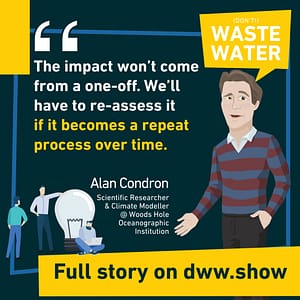
Yeah. It, at that, I think it is is one of the biggest, yeah. But I think if people are, you know, thinking about funding this, I think they need to sort of take a step back then it doesn’t have to be the whole package to, to fund, to begin with. I think it should just be to do in a exploratory toes with icebergs, just to pull them, you know, pull an iceberg and into some warm water and see how quickly it mounts and we can model it.
But at the end of the day to validate the model to make sure the model is working, doing the right thing. You have to have the tow to validate it against, and it would be very straight forward to go and you go and do that, but just simply put a line around an iceberg, move it and see how it survives.
Proving the Iceberg model right (or wrong)
It’s surprising. The iceberg thing is there’s been sort of coming full circle now as we’ve, you know, there’s been a long history about it. There’s been. Lots of things written about it. There’s been lots of, you know, cool pictures in magazines of, you know, Photoshop lions bergs off shore of, you know, tropical beaches and things.
But there is just sort of at the end of the day, a lot of, sort of the basic ideas of performing the toe is still Ray Paulina. What is the best way to tell an iceberg? You know, is it just a line? I mean, the Canadians routinely tell icebergs often Newfoundland to to stop them crashing into oil rigs, for example, but they’re only telling them for maybe a couple of days at the most.
Right. So what does, you know, what does that look like when you’re trying to, and I spoke for a month? On end. What does the iceberg look like that you want to pack? Here’s another thing, you know, what shape is it? I mean, perhaps something that’s, you don’t want something that’s totally square because it could be really slow and hard to toe, maybe something that’s more kind of like long kind of rectangle.
That for example would be good. How do you sweat the ice, but what does the science book look like? You don’t want an iceberg that has been drifting in the ocean for years and years, because what they become, become like a rotten ice after awhile where the, you know, the salt gets into the ice.
Overcoming the (un)expected caveats
Right. And then you end up this kind of red, brittle material, just essentially, it was sort of crumble. If you try to move it to one side there’s license, sort of new you know, what’s the best place to go and find the science. And then as you know, as you perform this, Tony, you need to do it in a scientific way.
So you would need that step one on monitor how this iceberg is deteriorating. For example, be cool to use, say, underwater robots to image the iceberg perhaps every day or every half a day or something to see how the shapes changing. And from that, and youth work out, you know, how much mass loss you were getting from the iceberg, how fast it was mounting.
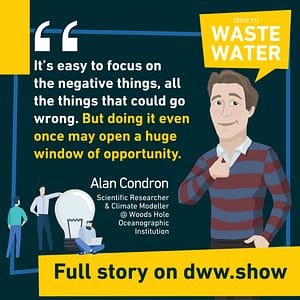
And if you don’t perform that over the entire time, Get an idea about how quickly the icebergs deteriorating you could estimate. You could have sensors on these little robots, for example, where you could change, you know, detect any changes in wash temperatures that may affect, you know, the ecology, for example, the whole sort of iceberg turning package.
Is it just this stage? It really just needs some basic long toes being performed to sort of validate and to test, you know, the viability of doing.
Stay tuned… or be patient!
Antoine Walter: It’s quite funny because it’s a topic we’ve been discussing in totally different areas of the water words are on that microphone, you know, of how you model a treatment plans.
But at some point, once your model is very detailed, you need to have an actual real plans to just calibrate your, your, your model and to then fine tune it and refined it and come to the final shape where you have a model, which is a digital twin. So I feel like if I get your rights, then that’s the next step for you?
Which is someone. So knowing that iceberg that you can study it and then calibrate your model and then finally probably optimize the way it’s done. So I think it’s going to be something really, really fascinating to follow, but on the other end, Puts exactly as much chances that in 50 years from now, another podcaster is making another interview with another scientist and saying, Hey, that is really a hot topic.
Because when I was reading what John, his ex was writing, I think it’s he’s, he passed in 1980. But when I read what he was writing was really what was expecting that in the next 10 to 20 years, that was going to become mainstream. So future will tell that it was a fascinating, deep dive. I propose you to switch to the rapid for a question.
Alan Condron: Yeah, let’s do the rapid fire questions. Sounds good.
Rapid fire questions:
Antoine Walter: So in that last section, I’m asking short questions. I’m trying to be. Less vocal than I was so far. I was really talking a lot today. Sorry for that. But it’s really fascinating topic to me. And if you can keep the answers short, then we are within the topic of the rapid fire questions.
First one:
What is the most exciting project you’ve been working on and why?
Alan Condron: Yeah, it’s not a good question. I mean, I think the, I mean the iceberg towing is it’s certainly a fascinating topic. I should point out. It’s not really my it’s not one of my, always my main topic. Anyway, we do a lot of Antarctic climate research in general.
And that’s sort of the main, one of my main focus is see level, future, sea level rise and future climate change.
What’s your favorite part of your current job?
Alan Condron: That’s probably a, the flexibility of the job actually, and the ability to, to some extent anyway, to be able to choose, you know, what you work on.
Right? So the iceberg topics is probably a good example of something that would be hard to work on. If it wasn’t at woods hole.
What is the trend to watch out for in the water industry?
Alan Condron: That’s a good question. I mean, I don’t really have a solid answer for that. I mean, it’s discussed various other ways to extract water from things like dehumidifiers.
For example as time goes on, I think the demand, the need and the demand will change our ways of looking at what we consider now to be viable water sources.
What is the thing you care about the most when you’re working on a new project and what is the one you care the least?
Alan Condron: For it. Yeah. For a new project, I think well, in all my projects, actually, I mean the scientific accuracy of the work I’m doing, making sure that you know, the results are correct, but also doing sciences sort of society relevant to things that you feel it can impact society as a whole.
And whereas the one who cared the
Antoine Walter: least,
Alan Condron: I don’t think there is something I can at least.
Do you have sources to recommend to keep up with the water and wastewater market trends?
Alan Condron: Unfortunately, I did not have a good answer for that question.
Antoine Walter: And final question. Would you have someone to recommend me that I should definitely invite on that same microphone?
Alan Condron: I mean, perhaps given all the discussion about Nick Sloane, I think it would be a perfect candidate. It’d be nice to hear where he’s out with his is telling project.
Antoine Walter: Perfect. That sounds like, yeah, the perfect follow-up to our discussion today. Well, Alan, it was a pleasure to meet you to dive into that word, which I didn’t know at all before starting.
And I’m glad that you mentioned this, assigning it, a being something important to you, because that sounds reassuring to me because I mean, when you just hear that as a fantasy, it can sound like really a fantasy, but it sounds at the second pass to be much more tangible. Then this raised eyebrow I had at the very beginning.
Conclusion
So thanks a lot. And I’d be very happy to have you again, to prove your model right or wrong once to the first two, actually.
Alan Condron: Yeah, it was a pleasure. Thank you very much, right. To come back and chat more about other than an update of what we’ve been.
Thanks for listening to don’t wastewater. This podcast was brought to you by GF piping systems. Loved this episode, head over to apple podcast, to subscribe rate, and leave a review. See you next time.

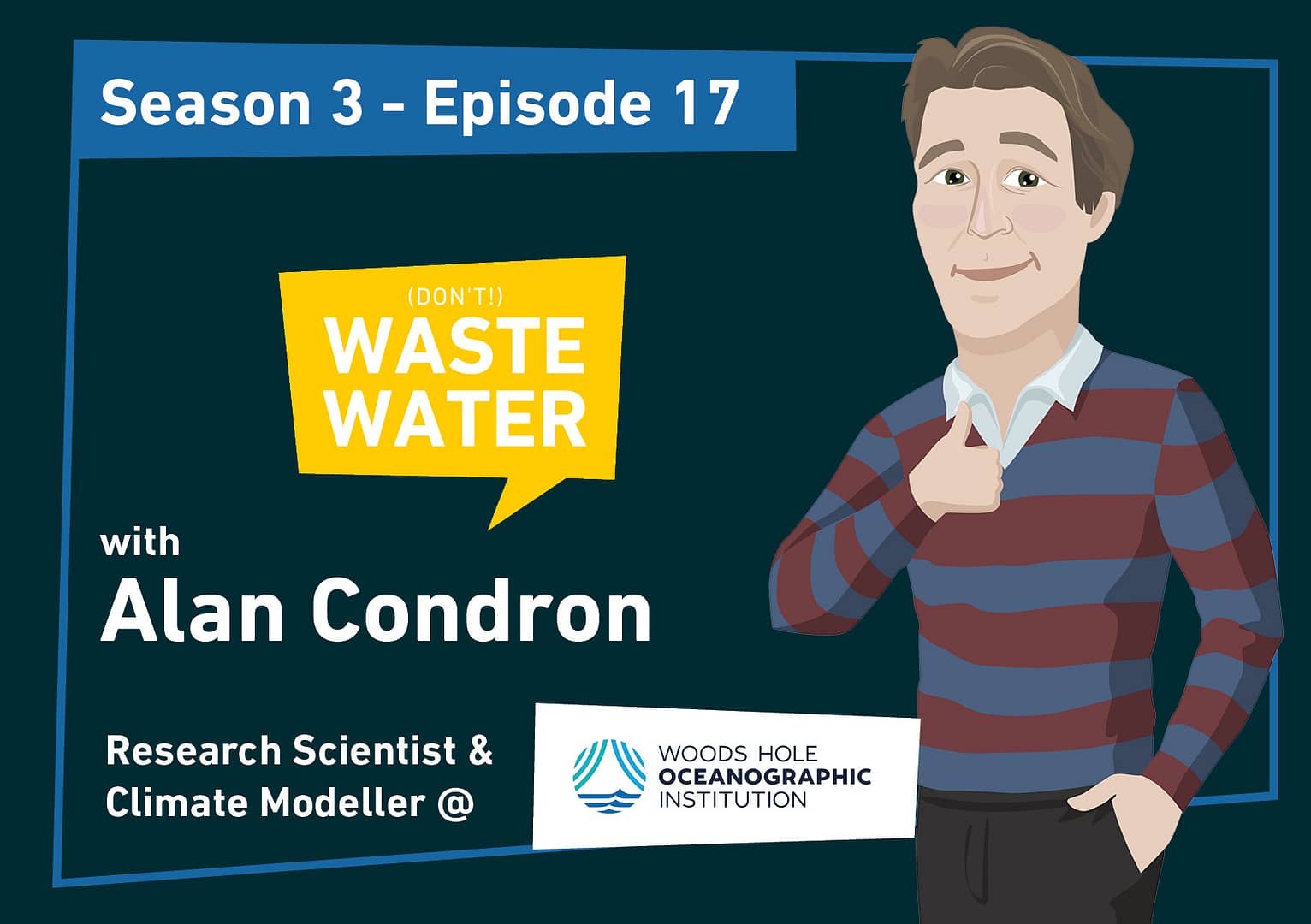











1 thought on “A Climate Modeller’s Truth on the Controversial Project of Iceberg Harvesting”